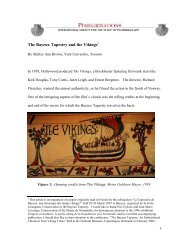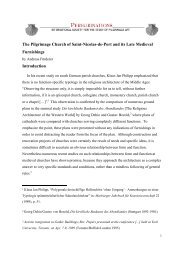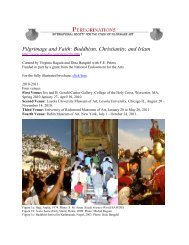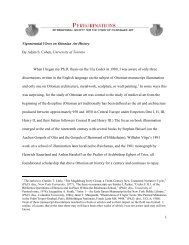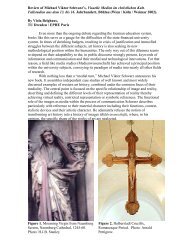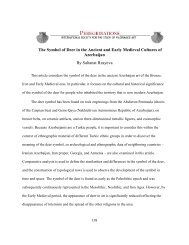The Bayeux Tapestry as a Religious - Peregrinations
The Bayeux Tapestry as a Religious - Peregrinations
The Bayeux Tapestry as a Religious - Peregrinations
You also want an ePaper? Increase the reach of your titles
YUMPU automatically turns print PDFs into web optimized ePapers that Google loves.
Figure 18: Griffin. Detail from the <strong>Bayeux</strong> <strong>Tapestry</strong> – 11th Century<br />
by special permission of the City of <strong>Bayeux</strong>.<br />
Griffins were <strong>as</strong>sociated with Christ <strong>as</strong> well <strong>as</strong> being guardian spirits. In a scene in the <strong>Tapestry</strong>,<br />
where the Normans are despoiling the English countryside, we can see griffins in the border and<br />
a rather tipsy looking bull, the traditional symbol of the St. Luke the Evangelist.<br />
Wolves abound in the borders of the <strong>Tapestry</strong>, either singly or <strong>as</strong> part of the various<br />
Fables. <strong>The</strong>y were known, and feared, for their rapacity, greed and deviousness. St. Wulfstan,<br />
“Lupus” (d.1023) published a diatribe, a “Sermon of the Wolf to the English” in 1014. 28 This<br />
Sermon h<strong>as</strong> a certain relevance to the events depicted in the <strong>Tapestry</strong>. England w<strong>as</strong> overrun by<br />
Scandinavian invaders, and the fault, according to Wulfstan, lay with the English who had<br />
earned Divine wrath because of their sins. Eadmer of Canterbury w<strong>as</strong> to make the same<br />
judgment of the Conquest: the English were being punished by God for their iniquities. 29<br />
Animals appear in another form in the <strong>Tapestry</strong>: they populate the Fables that are to be<br />
found in the borders. 30 Aesop‟s tales were already widely known in the eleventh century. Marie<br />
de France, the great French medieval poet who worked at the court of Henry II and Eleanor of<br />
Aquitaine, claimed that she had translated Aesop‟s fables from the English original written by<br />
King Alfred the Great. R. Howard Bloch believes that the designer of the <strong>Tapestry</strong> and Marie de<br />
France were working from a common source. 31 <strong>The</strong>re are at le<strong>as</strong>t nine fables in the <strong>Tapestry</strong>,<br />
28 “Sermon of the Wolves to the English,” BL Cotton Nero A f.110.<br />
29 Cited in David M. Wilson, <strong>The</strong> <strong>Bayeux</strong> <strong>Tapestry</strong>, 9.<br />
30 Joyce E. Salisbury, “Human Animals of Medieval Fables,” in Animals in the Middle Ages, ed. Nora C. Flores<br />
(New York: Routledge, 2000), 49-65; Kenneth Clark, Animals and Men: <strong>The</strong>ir Relationship <strong>as</strong> Reflected in Western<br />
Art (New York: William Morrow, 1977).<br />
31 R. Howard Bloch, A Needle, 123.<br />
155



